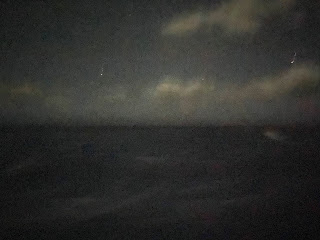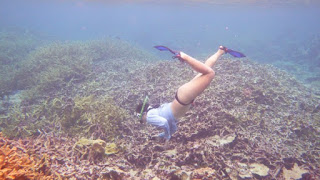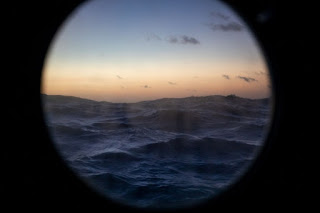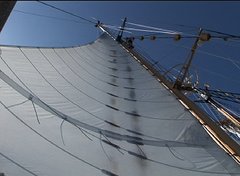I have dreamed of going to Palmyra since I was sixteen.
Over the past half decade I have envisioned ten thousand versions of the moment
I'd one day see it. None of the those imagined futures, not even the sum of all
them, could approach the magic of real thing.
The ship was predicted to spot land sometime early this
morning. I awoke at sunrise, slammed contact lenses into my eyeballs, and
blitzed above deck.
The sky was wispy-grey, with rippling sheets of
high-altitude clouds giving way to clear morning sky. On the far horizon,
underlit cumulous clouds radiated pale yellow like the floor of Olympus. A thin
gold line pierced through just above the horizon-the sun was edging upwards.
Minute by minute, light rays grew and spilled over the horizon and refracted on
the bottom of the clouds, which glowed orange, pink, and red. The full moon
stood watch above the multicolor drama.
There was Palmyra. Sixteen islets of silhouetted palms
rising straight up from the ocean. Some parts of the forest appeared from this
distance to be dense masses of jagged treetops, while others were thinner, and
the outlines of individual trees emerged.
A Watch (we work in A, B, and C Watch group teams; I am
in C Watch) was laughing happily as more folks came above deck and gazed baffled
at the land. We all smiled silently as we leaned over the railing, each letting
the realness of this moment filter through our own many imagined fantasies of
it. Of all the different emotions we were each feeling individually, a core
part of this experience carried the same inexplicable gravity for all of us.
*Aside: They had first spotted land that morning around
5:30 am (Erika shouted the definitive "Land Ho!"). About half an hour
before that, A Watch had seen something in the sky. Erika saw it from the bow,
and within seconds Vuk had rushed over and reported seeing the same thing: a
pencil-thin line of brilliant white light, the length of the moon's diameter,
streaking across the sky. And it didn't fade out-it soared on and on and
remained in the sky for full seconds. A Watch religiously maintains that that
they saw a UFO.*
The water was purple. Then the sun peaked up and splashed
it orange. Within a minute, the sky gave way to brilliant day.
*20 minutes later*
I'm sitting on the doghouse now. There is no wind so
we've revved up the engine to motor towards Palmyra, aiming to anchor at 0900
in the lagoon.
Now we're close enough to see color and depth on the
island. What were once solid grey outlines now reveal themselves as three
dimensional: there are forwardmost trees and trees receding into the distance
forming a cove around a lagoon. Waves are breaking on the reef and throwing
spray into the air.
We're under a mostly blue sky with a couple cloud puffs
but a cluster of heavy grey clouds are gathered over Palmyra. A grey cube of
opaque rain sheets down over the rightmost corner of the atoll.
All morning, I had thought that the island seemed
indifferent, stalwart-neither inviting nor shunning our approach. But now, as
the dark rain mass crawls across the whole island and masks the emergent
greens, blues, and whites back in grey, I sense the first note of foreboding.
The ominous dread consistently documented in the sailing logs and journal
entries of Palmyra-visiting mariners going two-and-a-half centuries back. (I
and everyone else journaling about today aboard the RCS joins that anthology).
*5 minutes later*
Suddenly we're close. Students are asked to stay on the
forward deck as the crew commandeers this tight, difficult channel entry. A
couple crew with walkie-talkies have climbed up forty feet to the top of the
rigging, another is standing on the bow, and Captain Greg stands with
commanding confidence on the quarterdeck near the helm, and Duncan steers. As
we enter the reef channel, crew members mandate that we all be quiet so
commands can be received and updates given between the RCS and the small dingy
manned by Palmyra staff, guiding us in.
No one would be speaking anyway. Language has melted away
at the feet of the temple we were entering. Towering jungle trees of shimmering
lime and deep dark green and every tone in between shoot up from the thinnest
band of visible soil, ringed by a couple meters of powder-white sand, lapped by
kissing baby waves. Above a single treetop circle five dozen boobies, moving
like a feeding cyclone over an abundant feast. In another single branched tree,
forty birds sit like porcelain Christmas lights. And that is every tree on this
dozen-acre-long-patch of outcropping paradise. And the then the next islet is
upon us: some different but equally spectacular wrangle of knotted up,
squawking forest-vibrantly, aggressively, defiantly alive.
We scan all around us. All of a sudden we are inside it,
in the lagoon. We are surrounded on all visible sides by these islets that
formed millions of years ago when a colossal ocean volcano subsided on a moving
tectonic plate down below the ocean surface and the coral reef growing around
its rim crept upwards a couple centimeters per year, just faster than the
volcano sank or the Pacific rose, and on the reef accumulated soil and sand,
and trees grew and shark swarmed and birds nested and Polynesian voyagers
stopped by during long voyages to catch fish and rest and then pass on, and
still not a single human soul stayed and lived in this mystical place until
just the last century.
Some of the islets are just a single, isolated, tall,
100-meter-across mottled mass of overgrown trees. Others are just five lone
trees on a little spit of sand in the middle of the lagoon. We float past each
in near silence. A deep, powerful rumble resonates from the edge of the reef,
where the Pacific crashes on the coral. The main ambient soundtrack is, of
course, the bird cries. Above that is the occasional click of some metal pulley
in the rigging, tapping the mast. Above that are the sporadic directions
Captain Greg is receiving through his radio and the updates he voices back.
Then, at a hushed murmur amidst that all, are our awed
whispers. Regina just described the silence as "reverent." I am
thinking of a quote from an essay I once read: "Language itself seems to
fall to pieces when it touches certain topics."
The water below us is blindingly blue and pierced with
sun rays. Farther on, surrounding the islets, the water is a pristinely
mint-green, iridescent snow-blue, and can't be deeper than a couple feet. The
magic of the moment is coupled by the gravity of the danger. Leaning over the
railing, we can see clear-blue down to the reef floor below. Our slow, tactical
entry over depths as shallow as twenty-five feet has incredibly high stakes.
"Mantas on the port side!" We all scramble to
the railing. Two meters from the side of the boat, four manta rays swim at the
surface. Each is about a meter across. They twirl and spin over for us. Their
wings playfully flap the water before they retreat below. Then the water is
calm for a minute, and then a blacktip reef shark passes by.
***
Within minutes, we had just seen all this. And we had
merely just glided in without yet even trying to explore the layers of wonders
alive and dead and undead in this place. Just then it collectively dawned on
us-like a radiantly sun-lit cumulous cloud drifting overhead during
sunrise-that we had entered an infinity. Unexplored and unexplorable depths of
beauty and diversity thrive here.

That realization was augmented by another: we had never
really "entered" an infinity because we had never left infinity. All
the world is endlessly magnificent in ways that every living, conscious, and
curious creature can spend their lives trying to understand. No matter if we
try to master some portion of the night sky, a transect of the sea, a single
islet, or a small patch of soil, we will never explore to the ends of all its
dimensions. The world in its infinite complexity spans out farther and
macroscopically bigger-but also more inward and microscopically smaller!-than
any of its inhabitants can ever hope to comprehend.
Then, a third realization came: the endless beauty
drifting past us before our eyes, and the endless beauty of the whole planet
that hosts it, is the same infinity that we carry in each of ourselves.
Staring at the sun's glistening reflection in the water,
picking up and letting go and picking up and letting go each of these
infinities, I accepted that I could hold them all at once. And I was blissfully
content with that.
- Charlie
Hoffs






.jpg)
















